Kawasaki Heavy Industries Bundle
How did Kawasaki Heavy Industries become a global powerhouse?
Journey back in time to explore the fascinating Kawasaki Heavy Industries SWOT Analysis and the compelling story of a company that has shaped global industry. From its inception in 1878 as a shipbuilding venture, Kawasaki's evolution mirrors Japan's remarkable industrial rise. Discover the key milestones and strategic pivots that transformed a humble shipyard into a multinational industrial conglomerate.
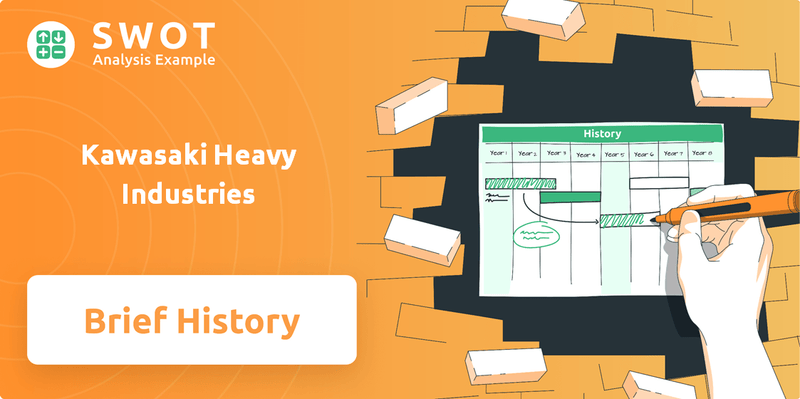
This brief overview of Kawasaki Heavy Industries delves into the early history of Kawasaki shipbuilding, tracing its roots back to the need for modern vessels. Examining the KHI company timeline reveals a commitment to innovation, as the company expanded beyond its initial focus. Today, Kawasaki Heavy Industries stands as a testament to adaptability and strategic foresight, with a significant global presence and a diverse portfolio of products.
What is the Kawasaki Heavy Industries Founding Story?
The story of Kawasaki Heavy Industries, or KHI, begins with Shozo Kawasaki. He established the Kawasaki Tsukiji Shipyard in Tokyo in April 1878. This marked the official beginning of what would become a major industrial force in Japan and globally.
Shozo Kawasaki's journey to founding the company was shaped by his experiences. He saw the need to modernize Japan's fleet, which primarily used traditional boats. This led him to focus on Western-style oceangoing steel ships.
The early history of Kawasaki shipbuilding is a story of vision and adaptation. It reflects Japan's rapid industrialization during the late 19th century. The company's evolution showcases its ability to seize opportunities and navigate challenges.
Shozo Kawasaki, born in Kagoshima, started the Kawasaki Tsukiji Shipyard in Tokyo in April 1878. His initial focus was on building and repairing ships.
- Shozo Kawasaki, a former kimono merchant, was inspired by the need for modern ships after witnessing ship accidents.
- He secured government support from Masayoshi Matsukata, the Vice Minister of Finance.
- The original business model centered on ship construction and repair, setting the stage for Kawasaki's future diversification.
- The company's early success was influenced by the rapid industrialization of Japan.
In 1886, the business moved from Tokyo to Hyogo and was renamed Kawasaki Dockyard. This expansion and renaming marked a significant step in the company's growth. The company's transformation into a public entity in 1896, as Kawasaki Dockyard Co., Ltd., was influenced by the shipbuilding industry's prosperity during the Sino-Japanese War of 1894. This strategic move allowed Kawasaki to handle a surge in orders and cement its position in the market. The appointment of Kojiro Matsukata as the first president of the public company, at the suggestion of Shozo Kawasaki, further solidified the company's leadership.
The company's evolution reflects Japan's broader industrial growth. The early focus on shipbuilding laid the groundwork for Kawasaki's expansion into various industrial sectors. The Revenue Streams & Business Model of Kawasaki Heavy Industries explores how the company has diversified over the years.
KHI's early success in shipbuilding set the stage for its future diversification. This diversification would eventually include areas such as aircraft manufacturing, heavy machinery, and more. The company's ability to adapt and innovate has been a key factor in its longevity and success.
Kawasaki Heavy Industries SWOT Analysis
- Complete SWOT Breakdown
- Fully Customizable
- Editable in Excel & Word
- Professional Formatting
- Investor-Ready Format
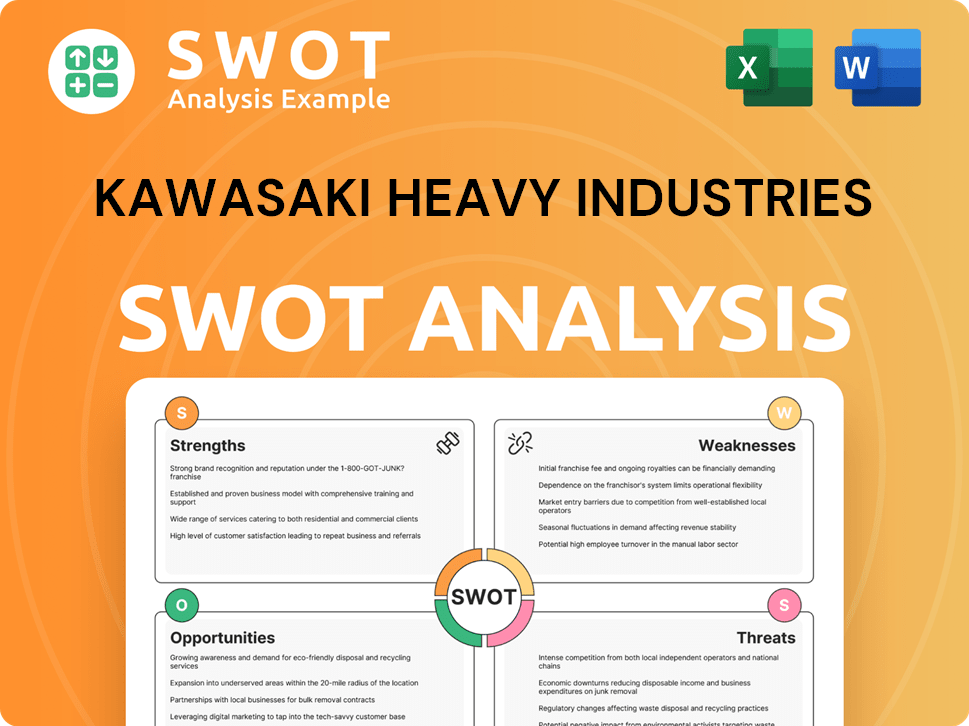
What Drove the Early Growth of Kawasaki Heavy Industries?
The early years of Kawasaki Heavy Industries, following its 1896 incorporation, were marked by significant growth and diversification. Under the leadership of Kojiro Matsukata, the company expanded its shipbuilding capabilities and entered new manufacturing areas. This period saw the company evolve from shipbuilding into a multifaceted industrial conglomerate, laying the groundwork for its future.
In 1897, after becoming a publicly traded company, Kawasaki Heavy Industries launched its first cargo-passenger ship, the Iyomaru. The construction of a new dry dock, completed in 1902, significantly increased shipbuilding capacity. This early focus on shipbuilding was crucial in establishing the company's initial industrial footprint.
The opening of the Hyogo Works in 1906 marked Kawasaki history's entry into railway car manufacturing. This expansion included locomotives, freight and passenger cars, and bridge girders. By the end of World War I, the company had diversified further, producing parts for the automotive and airplane industries, showcasing its adaptability.
In 1919, Kawasaki Heavy Industries introduced Japan's first eight-hour working day. The company adopted its present name in 1939. A major restructuring occurred in 1950, with the steel division being spun off, reflecting evolving business strategies.
In 1969, the merger of Kawasaki Dockyard, Kawasaki Rolling Stock Manufacturing, and Kawasaki Aircraft created the present-day Kawasaki Heavy Industries, Ltd. This strategic move strengthened its foundation. This reintegration was a strategic move to create a more unified conglomerate, setting the stage for future growth.
Kawasaki Heavy Industries PESTLE Analysis
- Covers All 6 PESTLE Categories
- No Research Needed – Save Hours of Work
- Built by Experts, Trusted by Consultants
- Instant Download, Ready to Use
- 100% Editable, Fully Customizable
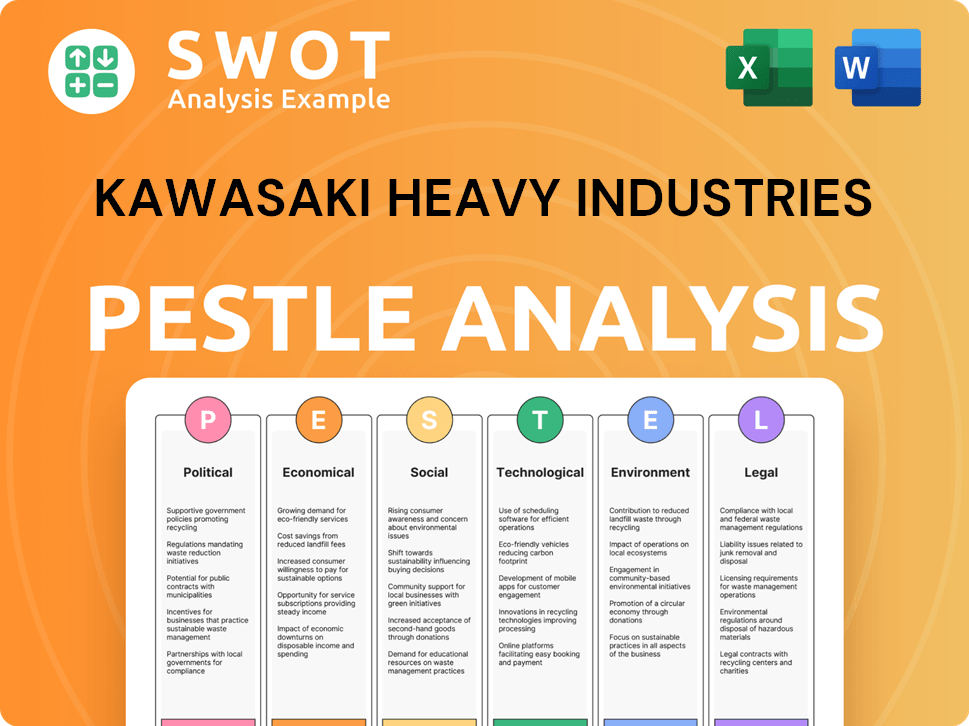
What are the key Milestones in Kawasaki Heavy Industries history?
The Kawasaki Heavy Industries (KHI) has a rich history marked by significant milestones in Japanese manufacturing. From its early beginnings in shipbuilding to its expansion into diverse sectors, the company's timeline reflects a journey of innovation and adaptation. The company's evolution showcases its resilience and ability to navigate the complexities of the global market, contributing significantly to the industrial landscape.
| Year | Milestone |
|---|---|
| 1906 | Built Japan's first submarine, marking its entry into shipbuilding. |
| 1922 | Completed its first airplane, expanding into the aerospace industry. |
| 1933 | Began manufacturing and selling Rokkogo automobiles, diversifying its product range. |
| 1952 | Signed a technical agreement with Bell Aircraft Corporation, leading to helicopter development. |
| 1968 | Entered a technical agreement with Unimation Inc., pioneering industrial robotics in Japan. |
| 1969 | Launched the H1 motorcycle, entering the consumer market with a popular product. |
| 1972 | Introduced the Z1 motorcycle, featuring an air-cooled, 4-stroke, 4-cylinder, 903 cm3 DOHC engine. |
| 1973 | Began selling Jet Ski personal watercraft, expanding into recreational products. |
| 2022 | Launched the SUISO FRONTIER, the first international transport of liquefied hydrogen. |
| 2024 | Received the 'Hydrogen Technology of the Year 2024' award for its 100% hydrogen-fueled cogeneration system. |
| 2025 | Received the 'Embraer Best Suppliers of the Year 2024' award for structures in April 2025, recognizing its high-quality components and adherence to delivery schedules. |
Kawasaki Heavy Industries has consistently pushed the boundaries of innovation. The company's focus on hydrogen energy, demonstrated by the SUISO FRONTIER and the hydrogen-fueled cogeneration system, highlights its commitment to sustainable technologies. Furthermore, its advancements in robotics, including a robotic arm for Dexterity and plans for humanoid and surgical robots, showcase its dedication to technological leadership and adaptability.
The SUISO FRONTIER project, launched in 2022, marked a significant step in the international transport of liquefied hydrogen. This initiative is part of KHI's broader strategy to contribute to decarbonization efforts and develop sustainable energy solutions.
KHI is developing advanced robotics, including a robotic arm for Dexterity, and planning humanoid robots and surgical robot systems. These innovations aim to enhance efficiency and capabilities across various sectors, reflecting its commitment to technological advancement.
In April 2025, KHI received the 'Embraer Best Suppliers of the Year 2024' award for structures, highlighting its commitment to quality and timely delivery in the aerospace sector. This recognition underscores KHI's reliability and expertise in manufacturing high-quality components.
The Kawasaki history is also marked by challenges that have shaped its strategic direction. The company faced financial difficulties during the Depression in 1929 and experienced losses in the late 1990s due to the strong yen and economic downturn. In response, KHI implemented business restructuring plans to adapt to changing market conditions.
The company faced financial difficulties during the Depression in 1929 and the late 1990s due to the appreciation of the yen and economic slumps. These challenges prompted strategic restructuring and diversification efforts.
In response to market challenges, KHI formulated a medium-term business plan, 'K21: From Heavy Industry to Flexible Enterprise,' focusing on customer needs and quality. This involved a shift from an order-driven to a solutions-driven business model.
KHI has concentrated its resources on core and growth areas, including aerospace, consumer products, machinery, rolling stock, and gas turbine and machinery. This strategic focus allows for better resource allocation and innovation.
A key challenge and opportunity is the global shift towards decarbonization. KHI's investment in hydrogen energy is a strategic move to address this challenge and capitalize on the growing demand for sustainable solutions.
For more insights into the company's core values and strategic direction, consider exploring Mission, Vision & Core Values of Kawasaki Heavy Industries.
Kawasaki Heavy Industries Business Model Canvas
- Complete 9-Block Business Model Canvas
- Effortlessly Communicate Your Business Strategy
- Investor-Ready BMC Format
- 100% Editable and Customizable
- Clear and Structured Layout
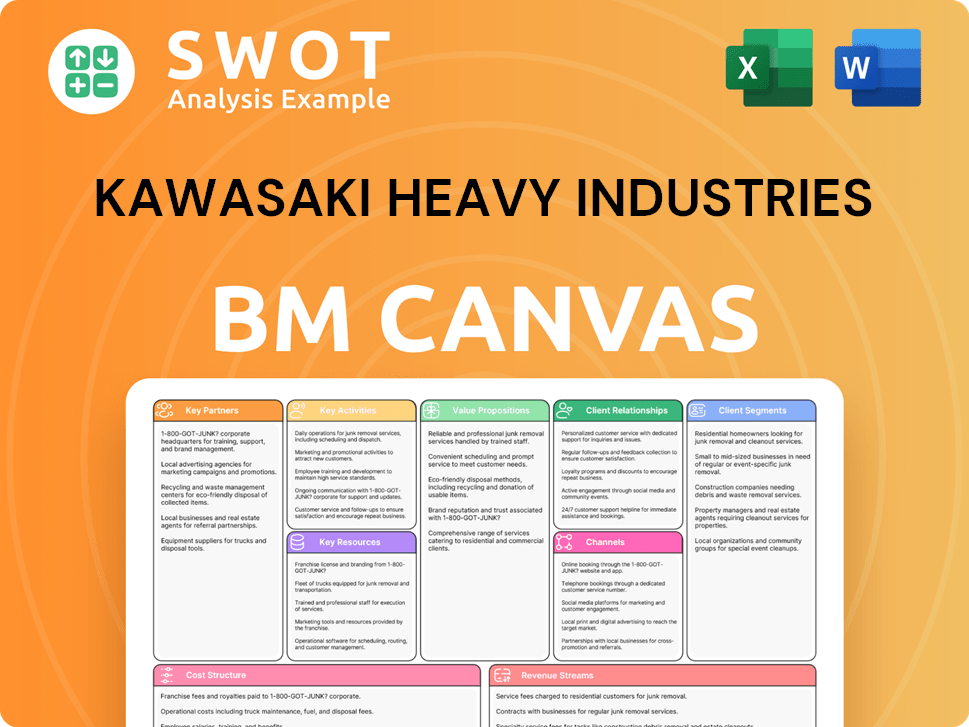
What is the Timeline of Key Events for Kawasaki Heavy Industries?
The Kawasaki Heavy Industries (KHI) company has a rich history, evolving from shipbuilding to a global industrial conglomerate. This evolution is marked by significant milestones in Japanese manufacturing and technological innovation, reflecting its adaptability and commitment to progress.
| Year | Key Event |
|---|---|
| 1878 | Shozo Kawasaki establishes the Kawasaki Tsukiji Shipyard in Tokyo, marking the beginning of the company's journey. |
| 1896 | Kawasaki Dockyard Co., Ltd. is incorporated, with Kojiro Matsukata as its first president, solidifying its presence in the industry. |
| 1906 | Hyogo Works opens, expanding the company's operations to include railway car manufacturing and marine steam turbines. |
| 1922 | The company completes its first airplane, demonstrating its expansion into the aviation sector. |
| 1939 | Adopts the name Kawasaki Heavy Industries, reflecting its diversification. |
| 1969 | Kawasaki Dockyard, Kawasaki Rolling Stock Manufacturing, and Kawasaki Aircraft merge to form Kawasaki Heavy Industries, Ltd., consolidating its various divisions. |
| 1969 | Develops Kawasaki-Unimate 2000, Japan's first industrial robot, showcasing its innovation in robotics. |
| 1975 | Becomes the first Japanese motor vehicle producer to manufacture motorcycles in the United States, expanding its global footprint. |
| 1981 | Delivers the first LNG carrier built in Japan, highlighting its expertise in shipbuilding. |
| 1991 | Tunnel boring machines successfully complete work on the Eurotunnel, demonstrating its engineering prowess. |
| 2000 | Formulates the 'K21: From Heavy Industry to Flexible Enterprise' medium-term business plan, aiming for profitability. |
| 2020 | Establishes 'Group Vision 2030: Trustworthy Solutions for the Future,' focusing on future technologies. |
| 2022 | Launches the SUISO FRONTIER, marking the first international transport of liquefied hydrogen. |
| 2024 | Included in the Dow Jones Sustainability World Index and recognized on the CDP 'A List' for climate action, demonstrating its commitment to sustainability. |
| 2025 | Kawasaki is set to showcase futuristic mobility concepts at Expo 2025 Osaka, Kansai, Japan, emphasizing hydrogen technology. |
KHI is heavily investing in hydrogen-related projects. The company aims to be a leader in decarbonization using hydrogen, with plans to launch the world's first liquefied hydrogen carrier and develop hydrogen turbines. A partnership with INPEX by 2024 is in place to strengthen the global hydrogen supply chain, with a goal to lower hydrogen costs to 30 JPY/Nm³ by 2030.
In the Power Sports & Engine segment, Kawasaki plans to invest over JPY30 billion by 2025 to double the production capacity of Recreational Off-highway Vehicles (ROVs) from 50,000 to 100,000 units annually. This includes new plants in the U.S. and Mexico. The company is also developing electrified and hydrogen-powered engines for motorcycles, with a strong hybrid motorcycle expected in 2024.
Kawasaki is proposing a new generation of railcars, including hydrogen fuel cell cars for carbon neutrality. It is also gaining market share in North America. The company is investing in digital transformation, using AI/ML and IoT for track inspection in its rail division, with plans to expand this digital strategy to other business lines such as robotics and hydrogen.
Analysts forecast Kawasaki Heavy Industries' revenue to grow 6.6% per annum on average over the next three years, surpassing the 4.4% growth forecast for the Japanese machinery industry. The company's earnings are also forecast to grow by 10.7% per year. This strong growth outlook highlights the company's strategic initiatives and focus on innovative technologies.
Kawasaki Heavy Industries Porter's Five Forces Analysis
- Covers All 5 Competitive Forces in Detail
- Structured for Consultants, Students, and Founders
- 100% Editable in Microsoft Word & Excel
- Instant Digital Download – Use Immediately
- Compatible with Mac & PC – Fully Unlocked
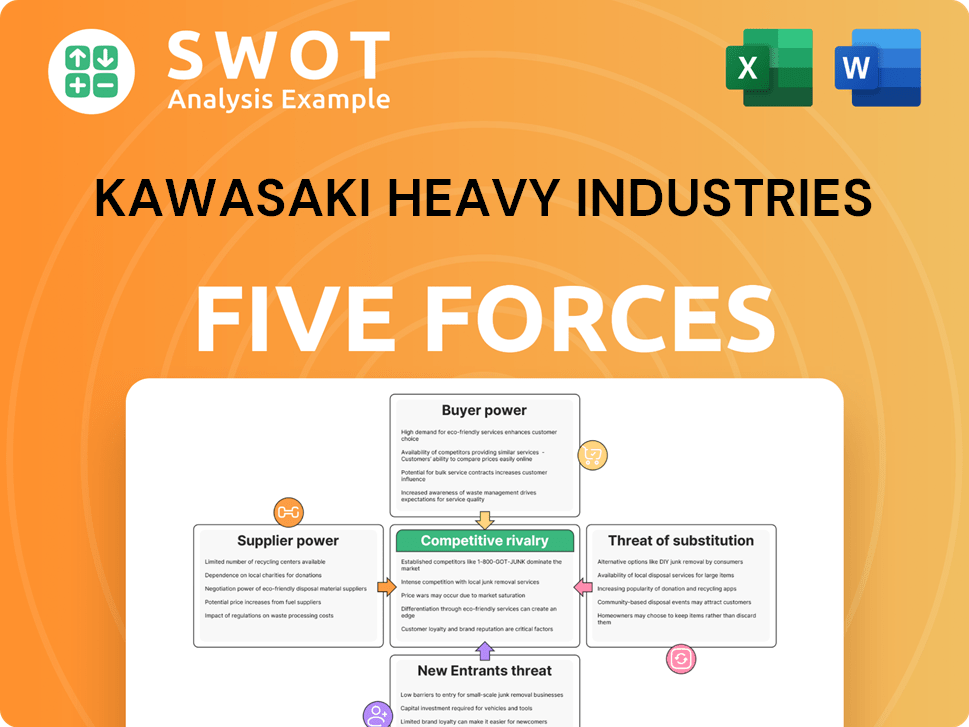
Related Blogs
- What is Competitive Landscape of Kawasaki Heavy Industries Company?
- What is Growth Strategy and Future Prospects of Kawasaki Heavy Industries Company?
- How Does Kawasaki Heavy Industries Company Work?
- What is Sales and Marketing Strategy of Kawasaki Heavy Industries Company?
- What is Brief History of Kawasaki Heavy Industries Company?
- Who Owns Kawasaki Heavy Industries Company?
- What is Customer Demographics and Target Market of Kawasaki Heavy Industries Company?
Disclaimer
All information, articles, and product details provided on this website are for general informational and educational purposes only. We do not claim any ownership over, nor do we intend to infringe upon, any trademarks, copyrights, logos, brand names, or other intellectual property mentioned or depicted on this site. Such intellectual property remains the property of its respective owners, and any references here are made solely for identification or informational purposes, without implying any affiliation, endorsement, or partnership.
We make no representations or warranties, express or implied, regarding the accuracy, completeness, or suitability of any content or products presented. Nothing on this website should be construed as legal, tax, investment, financial, medical, or other professional advice. In addition, no part of this site—including articles or product references—constitutes a solicitation, recommendation, endorsement, advertisement, or offer to buy or sell any securities, franchises, or other financial instruments, particularly in jurisdictions where such activity would be unlawful.
All content is of a general nature and may not address the specific circumstances of any individual or entity. It is not a substitute for professional advice or services. Any actions you take based on the information provided here are strictly at your own risk. You accept full responsibility for any decisions or outcomes arising from your use of this website and agree to release us from any liability in connection with your use of, or reliance upon, the content or products found herein.